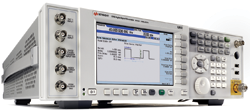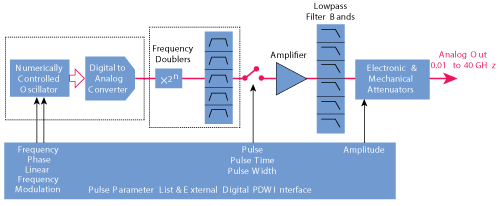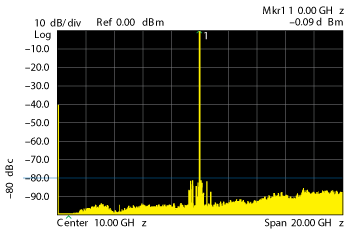
In recent years, various architectures have been used to develop the agile, wideband signal sources needed for threat simulation in electronic warfare (EW) applications. Similar approaches have been used to create local oscillators (LO) and RF pulse generators that can quickly switch over wide frequency and amplitude ranges.
These ideas were central to the creation of the new Keysight UXG agile signal generator shown in Figure 1. The UXG architecture uses a direct digital synthesizer (DDS) and new switching technology to create a signal generator ideally suited to applications that need an agile LO or require highly realistic simulation of EW environments. The DDS is built around a digital-to-analog converter (DAC) that was developed by Keysight to achieve dramatic improvements in dynamic range and phase noise.
Designing for Purity, Agility and Speed

Figure 1 The Keysight UXG agile signal generator (top) is a powerful building block as either a dependable LO or a scalable threat simulator.
The performance and capabilities of the UXG are based on three innovative technologies: DDS-based signal generation with an exceptional combination of purity and bandwidth, from 10 MHz to either 20 or 40 GHz; solid-state switches that change output levels in as little as 180 ns over large amplitude ranges and with accurate time alignment; and direct support for pulse descriptor words (PDW), the natural language of EW engineers, that enables efficient creation of complex and precise outputs.
The block diagram shown in Figure 2 illustrates the DDS-based architecture of the UXG. A high speed DAC is the heart of the DDS. An array of doublers and filters is used to multiply the signal up to a maximum frequency of 40 GHz. The DAC covers an octave centered at 1 GHz and provides dramatic improvements in dynamic range and phase noise. This results in very high purity signals, as shown in Figure 3.
This performance is available with industry-leading switching speed and very low latency for changing frequency. Frequency can be updated in as little as 180 ns. Depending on the selected instrument mode, the delay between an external command and frequency change (i.e., latency) is as little as 370 ns. The UXG can also generate wide chirps 10 to 25 percent of the carrier frequency.
Comprehensive EW threat simulation needs amplitude agility that matches the source’s frequency agility. This requires coordinated switching from solid-state attenuators, which the UXG does using “nanoFET” MMICs invented and manufactured by Keysight. These new switches are designed for microwave and millimeter wave frequencies, with fast settling to minimize distortion of the pulse shape. The resulting 90 dB agile amplitude range can be used between output levels from 0 to -130 dBm, which handles a wide range of threat scenarios.

Figure 2 The architecture of the UXG enables accurate simulation of complex signal scenarios through fast switching, phase repeatability and extensive pulse-modulation capabilities.
To optimize cost and capability for different applications, the solid-state agile attenuator is optional.
For some threat environment scenarios, it is essential to maintain specific phase and frequency relationships while signals are pulsed, frequency-hopped or interleaved in a sequence. The UXG produces any phase or frequency trajectory without limiting frequency or amplitude agility. It also maintains any desired relationships as frequency, amplitude and pulse characteristics are changed or as signals are pulsed on and off.
Multiple UXGs can be linked through clocks and triggers to provide phase coherence across the sources, making it possible to simulate steerable beam antennas or produce angle-of-arrival trajectories to evaluate direction-finding receivers.
Avoiding Surprises Late in the Development Process
The EW environment is an ongoing contest between the development and implementation of improved systems and the analysis and countermeasures needed to defeat those systems.
As implemented in the UXG, the DAC-based DDS architecture offers compelling advantages for EW applications, whether the need is for agile LO generation or PDW-based EW environment simulation:

Figure 3 In this 20 GHz spectrum measurement, a 10 GHz CW signal from the UXG signal generator exhibits high dynamic range, with a low noise floor and minimal spurious signals.
Signal quality – The UXG generates signals with low spurious and without the phase noise pedestal that is characteristic of systems that use phase-locked loops (PLL) instead of DDS.
Very high agility in frequency, amplitude and phase – All three aspects of the signal output can be updated in as little as 180 ns.
Support of multiple signals and complex scenarios – Sample sequences can represent multiple emitters from a single source.
Phase repeatability – Signal-generation calculations include phase accumulators programmed with any desired phase relationship.
Good match to evolving threats – The agility and flexibility of the UXG allows it to accurately simulate the equivalent characteristics of the modern threat environment and adapt as these threats change.
Simpler path from pulse requirements to actual signal output – The UXG can directly reproduce complex dynamic and pulsed signals by creating them mathematically from the desired pulse characteristics.
This last point is important: the UXG directly understands PDWs. Each word describes all the parameters of an individual pulse: frequency, duration, amplitude, chirp rate and more. Tables of PDWs can be transferred to UXG memory and complex sequences produced at high speed. Individual pulses can be as narrow as 10 ns, with 3 ns rise and fall times and an 90 dB on/off ratio. Marker outputs are available to coordinate execution of PDWs with other devices, and sequences of PDWs can be triggered and regulated by sending external triggers to the UXG.
With these capabilities, the UXG brings extensive and realistic testing to earlier stages of the design process, allowing engineers to optimize and verify system performance before the expense, potential delay and poor repeatability of field testing. It also significantly reduces the time from gathering new signal intelligence to creating realistic simulated threats.
Getting Closer to Reality
In development and mission data reprogramming, better testing performed sooner enables deeper confidence in the performance of EW systems. The Keysight UXG agile signal generator lets EW engineers create complex scenarios when they need them.
Off the shelf, the UXG is a powerful building block, whether the need is for a dependable LO or a scalable threat simulator. Because the UXG is fluent in the language of EW systems, it accelerates the conversion of new intelligence into up-to-date signal scenarios. With unmatched performance in switching speed and phase noise, the UXG makes it possible to generate increasingly complex simulations and get closer to reality.
Keysight Technologies Inc.
Santa Rosa, Calif.
www.keysight.com/find/UXG
